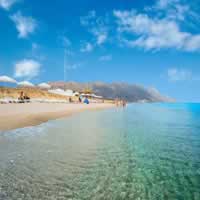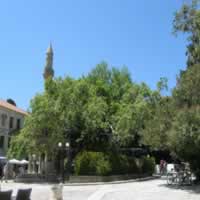Day 1 in Kos
Welcome to Kos! Arrive at the port in Kos and proceed to your hotel. After check in, grab a bite to eat before heading to the Asklepieion, Kos' most important archaeological site. This multilevel complex (dedicated to Asklepios, the god of medicine) is the mecca of modern Western medicine, where Hippocrates founded the first medical school in the late 5th century B.C.; and, for almost a thousand years after his death, was an important place of healing. Following your visit of the Asklepieion, continue on to Kos town via the small village of Platani (Kermentes), whose inhabitants are mostly Greek citizens of Turkish origin. Here you will find a mosque as well as an Orthodox church. There are also many traditional taverns if you decide you want to stop for some refreshment.
Kos town, the island's capital and main port, is dominated by Nerantzia Castle, also known as the Castle of the Knights (of St. John). The fortress is an imposing presence on the harbor, but little of interest remains inside the walls. From the castle, cross the bridge to the Tree of Hippocrates, where the famous 'father of modern medicine' once instructed his students. Afterwards, explore the ancient agora before visiting the Archaeological Museum of Kos, located in Eleftherias square, where you will see exhibits of beautiful mosaics, statues from the ancient site of Asklepeion, an extensive collection of prehistoric pottery and metallic objects, coins and more.
Next, continue your tour of Kos with stops at its other significant archaeological sites, including the Altar of Dionysos and Casa Romana, a beautiful mansion with a style similar to the buildings found in Pompeii. It dates from the 2nd century and features thirty-six rooms, three atriums with small fountains and many remarkable frescoes and statues. You'll also want to be sure to see the Baptistery, the Roman Odeon, the Western Excavations and the ancient Stadium.
After a busy day of sightseeing, enjoy a seafood dinner and drinks in one of the many cafes, taverns, or restaurants to be found along the harbor and main pedestrian street. And later, experience the famous nightlife of Kos in its numerous clubs where you will be sure to find music, dancing and entertainment to suit any taste!



Day 2 in Kos
Wake up early this morning and head to Tigaki Beach, one of the most beautiful places to enjoy a refreshing swim or to relax while sunbathing on its soft white sands. This beach is a popular place for water sports and you will find the necessary equipment, lounge chairs and umbrellas available for rent. Tigaki also offers many shops, cafes and taverns for your enjoyment.
Following a morning of fun in the sun, take time to explore the more remote and authentic interior villages of Kos, which were once the true center of the island. Asfendiou is one of the most attractive villages of Kos, lying on the slopes of Mount Dikaion. The highest point is Mount Dikeos, reaching almost 3,000 feet with amazing views of the island. From here, head to Zia (and nearby Asomatos), nestled in an idyllic location among lush green forests and refreshing spring waters with amazing sunset views. The three mile walk from Zia to Pyli will take you through a number of traditional island villages, including Lagoudi, where the beautiful church of Agios Ioannis Theologos stands on the massive rocks; and only a short distance from the village there is the small church of Prophet Elias. Along the way you'll pass the ruins of the Byzantine Castle of Old Pyli, which offers breathtaking views of the island of Kos, the Aegean Sea, the islands of Kalymnos and Pserimos and the neighboring coasts of Western Turkey. And finally, in Pyli, one of the oldest traditional villages of Kos, you will find the ruins of the tomb of ancient Harmylos.
Later, you may decide to return to Zia for a romantic dinner at the Sunset Taverna or continue on to Kardamena. Although one of the busiest and most modern resorts on Kos, Kardamena still has its charms, like the church of Agia Barbara, Agio Anargyroi and the beautiful church of the Virgin. Excavations have also uncovered the Temple of Apollo and an ancient theatre. Traditional taverns and restaurants serving delicious local specialties can be found along the waterfront while the nightlife in Kardamena is intense with numerous bars and clubs from which to choose!



Day 3 in Kos
Today, you'll want to visit the picturesque village of Antimachia, known for its traditional houses and for its local music and dancing tradition. Old working windmills are still the symbol of Antimachia and can be seen from every part of the village. Opposite the windmill, there is a restored house, known as the traditional house of Antimachia, a perfect example of a typical 20th century home. On a small hill above town, the Venetian Castle of Antimachia offers a magnificent view over the island of Kos. It was built in the early 14th century by the Order of the Knights of Saint John and the symbol of the Knights is engraved in marble above the entrance. Next to the fortress stands two Venetian churches, the church of Agios Nikolaos dating from the 16th century and the church of Agia Paraskevi, built in the early 18th century.
Afterwards, head to Mastichari, the port of Antimachia, where you can relax on the white sand beaches and enjoy a refreshing swim in the crystal waters before having lunch in one of the many seaside taverns. Time permitting you may want to take a ferry to the neighboring island of Kalymnos or visit the Hippocrates Garden Cultural Center. This private philosophical and cultural center is a replica of a 5th century BC Greek settlement surrounded by a beautiful garden with herbs, cedar trees, vineyards and fruit trees.
After lunch, continue south to Kefalos, a beautiful town that was the first capital of Kos. While exploring its labyrinth of narrow alleys, be sure to visit the Folklore Museum, which portrays the old rural way of life and has on display a rich collection of agricultural tools and traditional artifacts; as well as the ruins of the Christian Basilica of Agios Stefanos, located on a rocky spot just above the beach of Kamari, and the picturesque islet of Kastri, which is opposite the port. A bit further south is the lovely Monastery of Agios Ioannis (Saint John), known for its traditional architecture painted in blue and white. Beautiful icons and amazing frescoes decorate the walls and a golden chandelier hangs from the roof. Then, end the day watching the sunset at Sunset Wave beach, near Ayios Theologos, where you can also enjoy a delicious family-cooked feast at Agios Theologos Restaurant.



Additional Days in Kos
Should you be able to spend additional days on Kos then visit White Stone Cave ('Aspri Petra' Cave). Outstanding for their natural beauty, these caves have a historical relevance dating from the Neolithic Age and beyond. The prehistoric findings at the Cave of White Stone are considered one of the oldest archaeological monuments on Kos.
Additionally, offshore excursions are a popular choice. You can hop one of the daily ferries from Kardamena or Kefalos to the small island of Nissiros. Although not especially beautiful, it has an active volcano at its center, which last erupted in 1873. There are also daily ferries from Kos harbor to Bodrum, Turkey (ancient Halikarnassos). Please note that you must bring your passport to the boat an hour before sailing so that the captain can prepare the necessary documents for the Turkish port police.
Still others may enjoy lazing the days away on the numerous beaches - swimming, sunbathing, scuba diving - it is Greece after all! So grab a cocktail, kick back and relax.


Your Last Day in Kos
Depart your hotel for the airport for your return home. We recommend that you purchase a private transfer, if so a representative will meet you at the hotel, in time to take you to the airport for your flight out.
